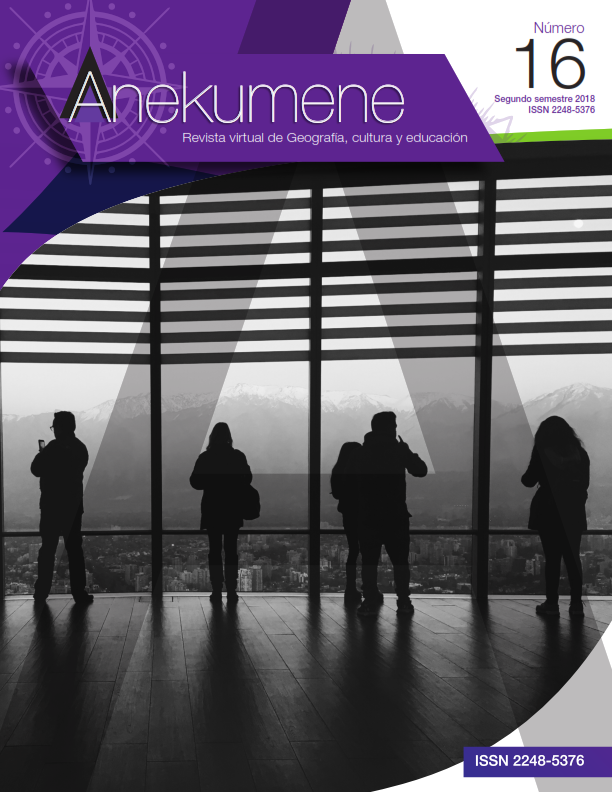‘Geoalfabetización’, ‘cartología’, desarrollo cognitivo y un juego móvil
Resumen
Algunas investigaciones en ciencias de la educación desarrollan juegos educativos en dispositivos móviles para incentivar el aprendizaje de hechos, conceptos y modelos geográficos en estudiantes de escuelas primarias. El desafío consiste en mejorar su alfabetización y fluidez geográfica, o geoalfabetización, y sus competencias en lectura de mapas antes de la adolescencia, sintetizadas aquí bajo la denominación de cartología, la cual parece ser un umbral crítico que obstruye el desarrollo cognitivo geoespacial de los adultos. Diseñar un juego educativo móvil implica integrar métodos conceptuales y prácticos para la enseñanza y aprendizaje de las competencias geoespaciales, conforme al currículo escolar. El marco teórico que se presenta vincula los mapas con la semiología cartográfica, las etapas de desarrollo cognitivo del niño referentes a la representación del espacio geográfico y el ciclo de aprendizaje experiencial. Este último supone una serie de procesos cartográficos esenciales que sirven de base a cualquier análisis o razonamiento geográfico: creación de mapas, visualización reflexiva y lectura cartográfica. El juego que se propone conjuga componentes de creciente complejidad en los cuales el mapa es protagonista en el transcurso de diferentes actividades: rondas típicas con reglas particulares sobre terrenos determinados; trayectorias geométricas y geoespaciales por trazar y seguir durante el juego; temas específicos relacionados con las asignaturas escolares y con los objetivos propuestos por los maestros, etc. Así, las discusiones geográficas dejan de preocuparse por el dónde para inquietarse por el porqué de las situaciones y el acontecer de los fenómenos.
Citas
Anderson, J. (2003). Cartography and children: At the dawn of its deve-lopment? Proceedings of the 21st International Cartographic Association (ICA) Conference, Durban, South Africa.
Ball, A. (2003). Geo-Literacy: Using technology to forge new ground. George Lucas Education Foundation, Edutopia. Recuperado de https://www.edutopia.org/geo-literacy-forging-new-ground.
Bateson, G. (1972). Steps to an ecology of mind. Chicago IL: University of Chicago Press.
Bednarz, S., Heffron, S. & Huynh, N. (Eds.). (2013). A Road Map for 21st Century Geography Education: Geography Education Research. Recommendations and Guidelines for Research in Geography Education. Washington, D. C.: Association of American Geographers.
Bertin, J. (1967). Sémiologie graphique : les diagrammes, les réseaux, les cartes. Paris: Mouton.
Bertin, J. (1983). Semiology of graphics: diagrams, networks, maps. Redlands, California: ESRI Press.
Bloom, B. (1994). Bloom’s taxonomy: A forty-year retrospective. Chicago IL: University of Chicago Press.
Catling, S. (1978). The child’s spatial conception and geographic education. Journal of Geography, 77(1), 24-28. DOI: https://doi.org/10.1080/00221347808980060
Catling, S. (1996). Technical interest in curriculum development: A programme of map skills. In M. Williams (Ed.), Understanding geographical and environmental education (pp. 93-111). London: Cassell.
Daniel, S. & Badard, T. (2008). Mobile Geospatial Augmented Reality, Games and Education: the GeoEduc3D project. Second International Workshop on Mobile Geospatial Augmented Reality, Québec City, Canada.
Edelson, D. (2012). Geo-Literacy: Preparation for 21st Century Decision-Ma-king. Washington DC: National Geographic Society (NGS) – Education. Retrieved from https://media.nationalgeographic.org/assets/file/Geo-Literacy_Backgrounder.pdf
Ferland, Y. & Kaszap, M. (2014a). Geoliteracy, geospatial learning threshold, and a fifth phase of cognitive development: Using digital maps and mobile serious games on the terrain. In Changes, Challenges, Responsibility. International Geographical Union (IGU) Regional Conference, Kraków, Poland.
Ferland, Y. & Kaszap, M. (2014b). Jeux sérieux éducatifs mobiles pour dépasser le seuil critique en littératie géospatiale. 2e Colloque international tic et Éducation, Montréal, Canada.
Ferland, Y. & Kaszap, M. (2017). Didactical & Learning Cycle of Geoliteracy for Mobile Serious Game Based on Maps. 28th International Cartographic Conference, Washington DC, USA.
Ferland, Y. & Mercier, G. (2004). A Theoretical Framework to Study the Structures of Urban Trajectories. International Geographic Union (IGU) Congress, Glasgow, Scotland.
Ferland, Y. (2000). Les défis théoriques à la cartographie mènent à la cognition. Cybergéo, Revue européenne électronique de géographie. Retrieved from http://cybergeo.revues.org/499.
Ferland, Y. (2007). Cartography Capabilities for Knowledge Representation. In Map Language and Geo-Information. 23rd International Cartographic Conference, Moscow, Russia.
Ferland, Y. (2011). La visualisation en cartographie théorique pour l’étude de la toponymie. 25th International Cartographic Conference, Paris, France.
Ferland, Y. (2015). La pédagogie par la toponymie à l’école. Congrès de la Fédération canadienne des sciences humaines (FedCan), Ottawa, Canada.
Ferland, Y. (2017). The Nominal Dimension of Geographical Space and Relations. Simpósio Internacional Pan-Americano de Toponímia (Sipat), Rio de Janeiro, Brazil.
Huizinga, J. (1955). Homo ludens: A study of the play-element [of] culture. Boston: Beacon Press.
Jonnaert, P. (2002). Compétences et socioconstructivisme: Un cadre théorique. Brussels: De Boeck.
Kaszap, M. & Ferland, Y. (2012). Jeu sérieux éducatif en univers social à l’extérieur sur appareil mobile. Colloque International tic et Éducation, Montréal, Canada.
Kaszap, M. & Ferland, Y. (2017). La géolittératie scolaire et la carte géographique comme instrument de développement de compétences en univers social. 4e Colloque International en Éducation, Montréal, Canada.
Kaszap, M., Ferland, Y. & Stan, C. (2013). How scenarios can enhance serious games with augmented reality. International Journal of Technology, Knowledge and Society, 8(4), 129-150. DOI: https://doi.org/10.18848/1832-3669/CGP/v08i04/56305
Kaufman, D. & Sauvé, L. (Eds.). (2010). educational gameplay and simula-tion environments: Case Studies and Lessons Learned. New York: igi Global.Kid World Citizen (2012). What is Geo-Literacy? Retrieved from: kidworl-dcitizen.org/what-is-geo-literacy. DOI: https://doi.org/10.4018/978-1-61520-731-2
Kolb, D. (1984). Experiential learning: Experience as the source of learning and development. Englewood Cliffs: Prentice-Hall.
Kolb, D., Rubin, I. & McIntyre, J. (1974). Organizational psychology: An experiential approach. Englewood Cliffs: Prentice-Hall.
MacEachren, A. (1995). How Maps Work: Representation, Visualization, and Design. New York: Guilford Press.
Mérenne-Schoumaker, B. (2012). Didactique de la géographie: organiser les apprentissages. Brussels: De Boeck.
Ministère de l’éducation du Québec (MÉQ). (2001). Programme de formation de l’école québécoise: éducation préscolaire et enseignement primaire. Québec: Gouvernement du Québec.
Monmonier, M. (1991). How to lie with maps. Chicago: University of Chi-cago Press.National Geographic Society (NGS). (2012). What is geoliteracy. Washington DC: NGS. Retrieved from: www.nationalgeographic.org/media/what-is-geoliteracy.
Nichols, S., Dobbin, J. & Ferland, Y. (2002). A partnership approach to distance education: An opportunity for land surveyors? Geomatica, 56(1), 45-49.
Organisation for Economic Cooperation and Development (OECD). (2000). Literacy in the Information Age: Final Report of the Inter-national Adult Literacy Survey. Canada: OECD.
Piaget, J. & Inhelder, B. (1947). La représentation de l’espace chez l’enfant. Paris: Presses Universitaires de France.
Piaget, J. (1962). Play, Dreams, and Imitation in Childhood. New York: Norton.
Piaget, J. (1967). Géométrie spontanée de l’enfant. In G. Holloway (Ed.), An introduction to “The child’s conception of geometry”. New York: National Froebel Foundation.
Stan, C., Kaszap, M. & Ferland, Y. (2017). La pensée historienne appliquée aux cartes anciennes à partir de la compréhension de l’espace. Traces, 55(1), 21-27.
Tufte, E. (1997). Visual explanations: Images and quantities, evidence and narrative. Cheshire: Graphics Press.
Vygotsky, L. (1967). Play and its role in the mental development of the child. Soviet Psychology, 5(3), 6-18. DOI: https://doi.org/10.2753/RPO1061-040505036
Descargas

Esta obra está bajo una licencia internacional Creative Commons Atribución-NoComercial 4.0.




